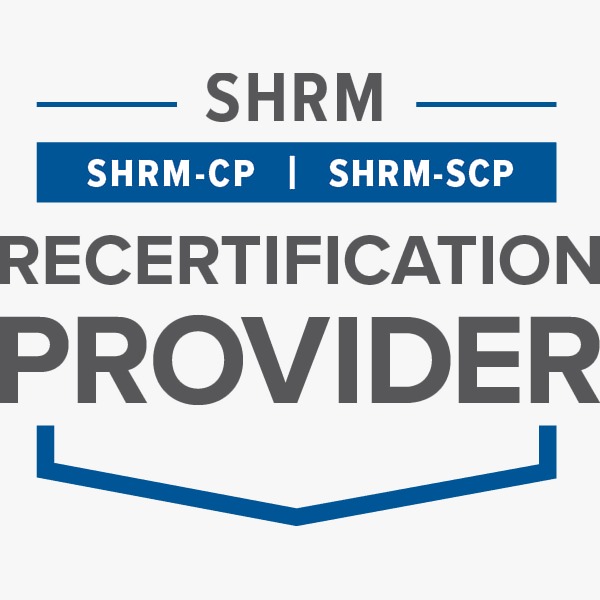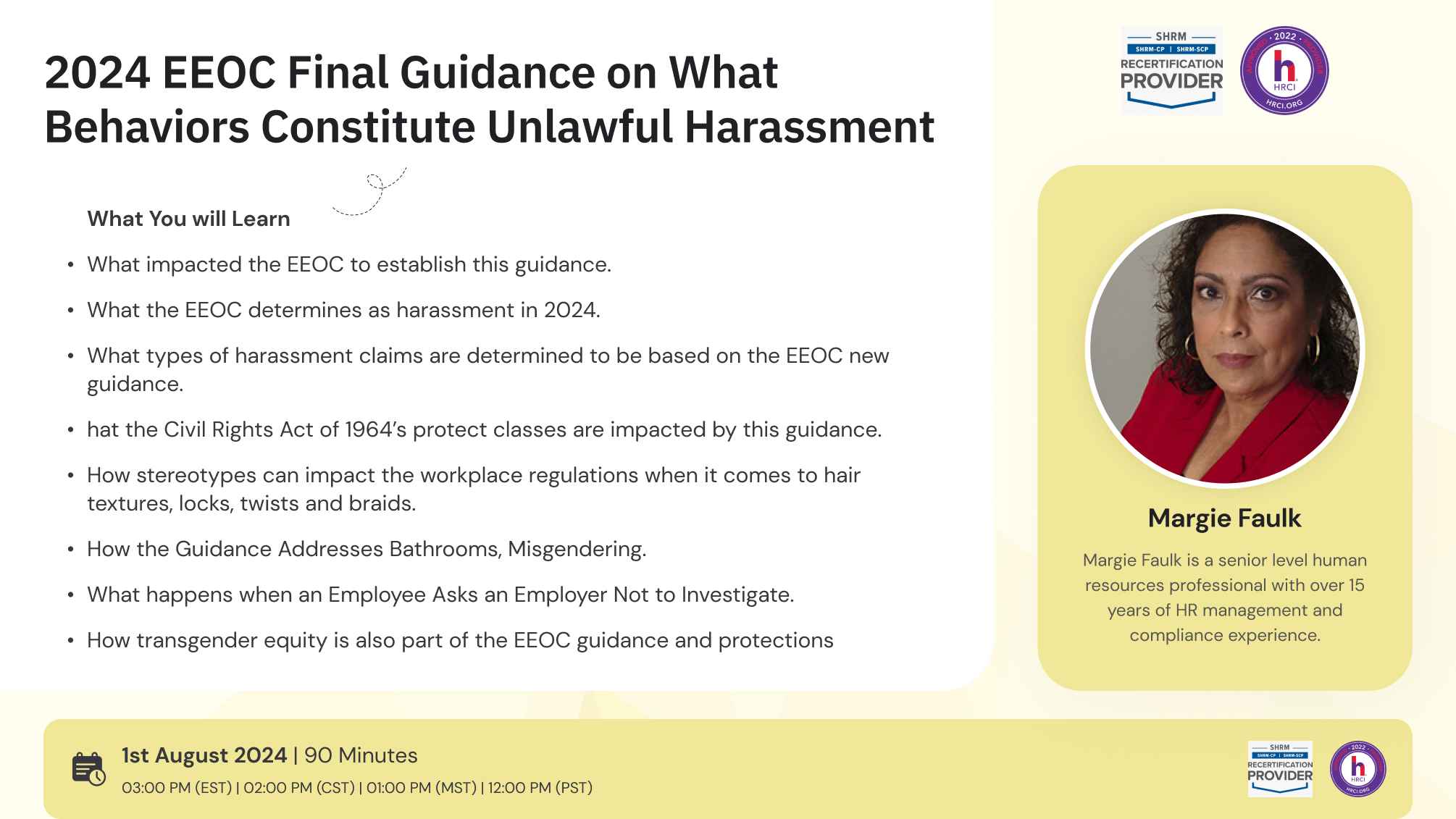- Topics
- Webinars
- Products & Services
Welcome To Biggest Online compliance Platform By LOCGFX Pvt. Ltd.
Human Resource & Payroll
The Equal Employment Opportunity Commission (EEOC) issued its first updated enforcement guidance on workplace harassment in 25 years on April 29, 2024. The guidance reflects a number of new developments concerning workplace discrimination and harassment and reflects U.S. Supreme Court precedent extending anti-discrimination protections to LGBTQ workers.
The EEOC had released the draft version of its guidance in September 2023 after an earlier effort to update existing guidance failed to gain traction during the Trump Administration.
The guidance does not constitute legally binding precedent, but it provides “legal analysis of standards for harassment and employer liability applicable to claims of harassment under the equal employment opportunity (EEO) statutes enforced by the Commission.” The new guidance supersedes several earlier EEOC guidance documents on harassment.
Workplace harassment” is more than just sexual harassment, the U.S. Equal Employment Opportunity Commission (EEOC) reminded employers in guidance published April 29. The commission shared specific examples of the kinds of harassment it deems unlawful—including harassment based on race, sex, religion and other factors.
- What impacted the EEOC to establish this guidance.
- What the EEOC determines as harassment in 2024.
- What types of harassment claims are determined to be based on the EEOC new guidance.
- What the Civil Rights Act of 1964’s protect classes are impacted by this guidance.
- How stereotypes can impact the workplace regulations when it comes to hair textures, locks, twists and braids.
- How the Guidance Addresses Bathrooms, Misgendering.
- What happens when an Employee Asks an Employer Not to Investigate.
- How Pregnancy, Childbirth, or Related Medical Conditions are part of the guidance and what Employers can and can’t do.
- How transgender equity is also part of the EEOC guidance and protections.
- How to develop an anti-harassment policy that meets EEOC guidelines.
The EEOC noted that since the Supreme Court held in 1986 that workplace harassment could constitute unlawful discrimination under Title VII of the Civil Rights Act of 1964, harassing conduct remains a serious problem in the workplace, representing more than one-third of the charges received by the EEOC over the last five years.
The enforcement guidance is broken down into the three components of a harassment claim: (1) the covered bases and causation; (2) discrimination respecting a term, condition, or privilege of employment; and (3) liability.
In order for harassment to be actionable under federal EEO statutes, the individual must establish the conduct occurred because of a statutorily protected characteristic. This is based on an examination of the totality of the circumstances. The guidance outlines a number of principles that are used to determine whether harassing conduct is based on protected characteristics. In doing so, however, the guidance notes that not all principles will apply in every instance.
- All Employers
- Business Owners
- Company Leadership
- Compliance professionals
- HR Professionals
- Managers
- Supervisors
- Employers in all industries
- Small Business Owners

Margie Faulk is a senior level human resources professional with over 15 years of HR management and compliance experience. A current Compliance Advisor for HR Compliance Solutions, LLC, Margie, has worked as an HR Compliance advisor for major corporations and small businesses in the small, large, private, public, Non-profit sectors and International compliance. Margie has provided small to large businesses with risk management strategies that protect companies and reduces potential workplace fines and penalties from violation of employment regulations. Margie is bilingual (Spanish) fluent and Bi-cultural. Margie’s area of expertise includes Criminal Background Screening Policies and auditing, I-9 document correction and storage compliance, Immigration compliance, employee handbook development, policy development, sexual harassment investigations/certified training, SOX regulations, payroll compliance, compliance consulting, monitoring US-based federal, state and local regulations, employee relations issues, internal investigations, HR management, compliance consulting, internal/external audits, and performance management. Margie’s unique training philosophy includes providing free customized tools for all attendees. These tools are customized and have been proven to be part an effective risk management strategy. Some of the customized tools include the I-9 Self Audit. Correction and Storage program, Ban the Box Decision Matrix Policy that Employers can provide in a dispute for allegations, Family Medical Leave Act (FMLA) Compliance Guide, Drug-Free Workplace Volatile Termination E-Book and other compliance program tools when attendees register and attend Margie’s trainings. Margie holds professional human resources certification (PHR) from the HR Certification Institution (HRCI) and SHRM-CP certification from the Society for Human Resources Management. Margie is a member of the Society of Corporate Compliance & Ethics (SCCE).

SHRM -
Compliancevent is recognized by SHRM to offer Professional Development Credits (PDCs) for the SHRM-CPSM or SHRM-SCPSM. This program is valid for 1.5 PDCs for the SHRM-CPSM or SHRM-SCPSM. For more information about certification or recertification, please visit - portal.shrm.org.

HRCI -
This webinar has been approved for 1.5 HR (General) re-certification credit hours toward California, GPHR, HRBP, HRMP, PHR, and SPHR recertification through the HR Certification Institute.
The use of this seal is not an endorsement by the HR Certification Institute of the quality of the activity. It means that this activity has met the HR Certification Institute’s criteria to be pre-approved for re-certification credit.
Sign up now on compliancevent.net. Visit compliancevent.net/webinar to discover a wide range of webinars from industry specialists. Tick on either ‘live webinar’ or ‘on-demand’, and simply click on ‘buy now’ to get enrolled.
You can refer compliancevent to anyone in your social circle. Explore your industry with your colleagues by getting them signed up on compliancevent.net today!
Go for the topic of your keen interest on compliancevent.net. Tick on ‘live webinar’ and get enrolled! Easy registration, transparent transaction.
You can request for an on-demand webinar that records the live webinar for you. After the webinar ends, you will have full access to the webinar’s recording. You can also explore compliancevent offline to order your webinar DVDs, flash drives and transcripts.
If you can’t attend the live webinar, simply go for the ‘on-demand webinar’ for the same price! Now, the live webinar recording will be saved in a cloud storage for you to access anytime from anywhere.
compliancevent offers both hard and soft copies of the webinars. It contains all the highlights as well as comprehensive descriptions of the webinar, so you never miss out a single detail.
After attending the live webinar, your certificate will be emailed to you. You can download it and add more charm to your professional score.
At the end of each webinar, you have the opportunity to interact with your industry experts, where you will get answers to all your queries.
Can’t attend the live webinar? compliancevent has got you covered! You can always switch to the on-demand webinar from your portal. You can also get your hands on the webinar’s DVD/flash drive and transcript. So order them now!
compliancevent brings a variety of options for offline learning. Order your DVDs, flash drives or transcripts now to have a lifetime access to compliancevent webinars. You can also go for on-demand recordings. Download and watch it anytime from anywhere in the world!
